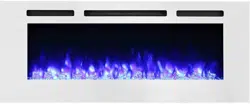Loading ...
Loading ...
Loading ...

16
NOTICE:
Do not move the glass panel when the appliance is plugged in and operating. This will cause the
control
panel to no longer function.
A harmless slight brief odor may occur during first use or not used for a long period of time. The
heater can be turned on without the flames. The red LED indicators will turn on for 10s
(one for low heating and two for high heating), and the 3
rd
fuel bed at 5% brightness will keep on.
There is a brief delay between the heater command and the heating turning ON. When the
appliance receives a heater ON command, the appliance blower will turn ON for 8 seconds before
the heater turns ON. There is also an 8 second delay between heater off and blower shut down.
Temperature Limiting Control
This appliance is equipped with a Temperature Limiting Control. Should the appliance reach
an unsafe temperature, the appliance will automatically turn OFF. To reset:
Turn the ON/OFF switch on the CONTROL PANEL to OFF. Unplug the power cord from the the
outlet or switch off circuit. Wait at least 15 minutes.
Inspect the fireplace to make sure no vents are blocked, or clogged with dust or lint. If they are,
use a vacuum to clean the vent areas.
With the POWER switch in the OFF position, plug the power cord back into the outlet .
If it switches off again, UNPLUG THE APPLIANCE RIGHT AWA Y! Have the outlets, wiring, and breaker
box inspected by a professional. Make necessary repairs before using the appliance.
•
•
•
•
•
•
•
5b. Remote Controls
Remote Control Battery
This remote control uses two AAA batteries (included).
Instrucons for battery installation are inside the Remote Control battery compartment.
Battery must be recycled or disposed of properly. Check with your local authority for recycling
advice in your area.
NOTICE:
Aim the remote control at the remote receiver. Make sure you hear a
beep each time
you press the button! If not, the fireplace will not respond to the signal.
•
•
•
Loading ...
Loading ...
Loading ...
